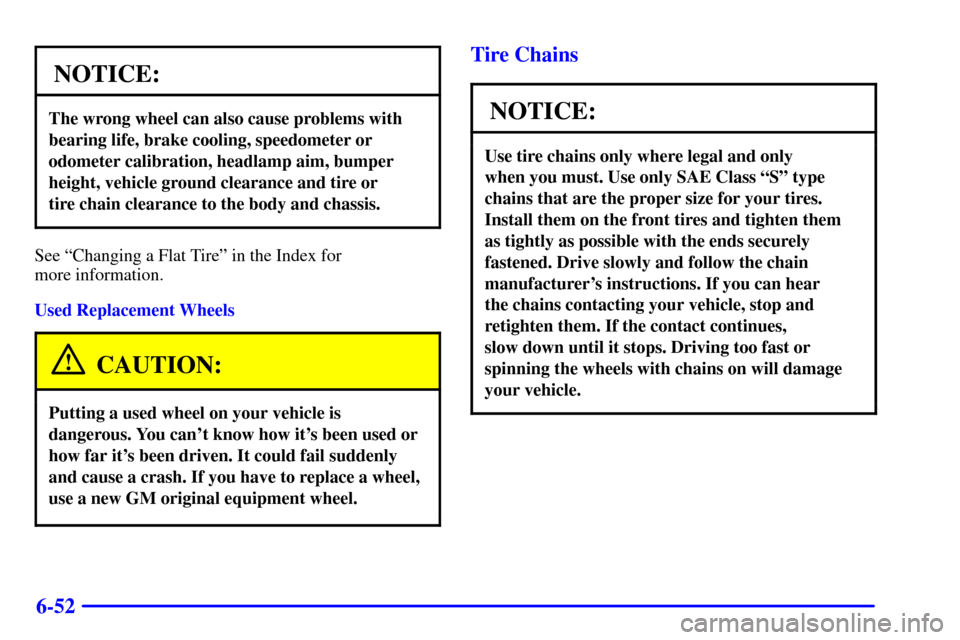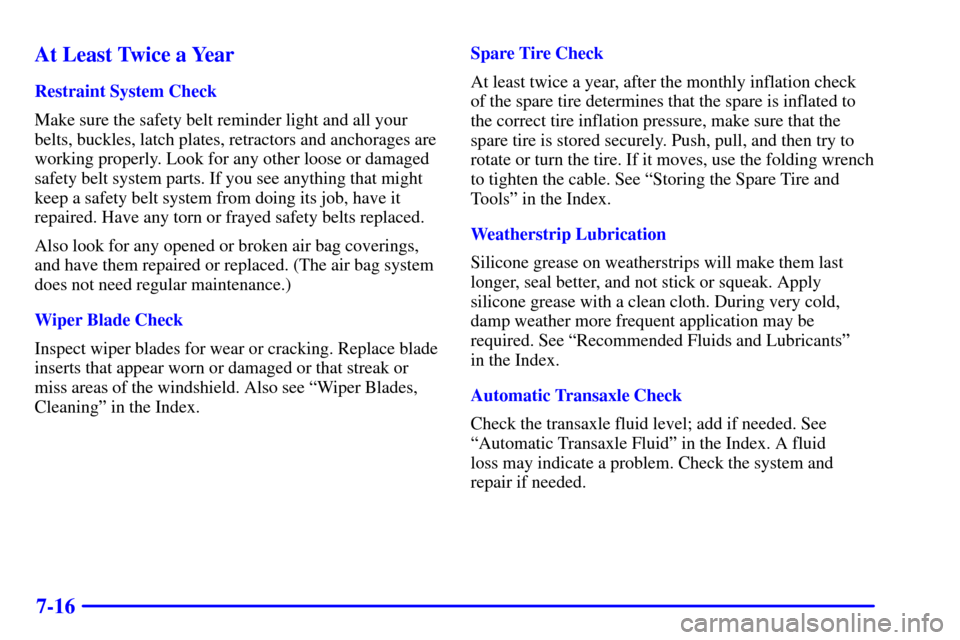Page 385 of 455
6-44
4. While holding the
wiper arm away from
the glass, push the
release clip from
under the blade.
5. Push the release clip at the connecting point of the
blade and the arm up. Then pull the blade assembly
down toward the glass to remove it from the wiper arm.
6. Push the new wiper blade securely on the wiper arm
until you hear the release clipªclickº into place.
7. Push the release clip, from Step 4, down to secure
the wiper blade into place.
Page 388 of 455

6-47 Tire Inspection and Rotation
Tires should be rotated every 6,000 to 8,000 miles
(10 000 to 13 000 km). Any time you notice unusual
wear, rotate your tires as soon as possible and check
wheel alignment. Also check for damaged tires or wheels.
See ªWhen It's Time for New Tiresº and ªWheel
Replacementº later in this section for more information.
Make sure the spare tire is stored securely. Push, pull,
and then try to rotate or turn the tire. If it moves, use the
folding wrench to tighten the cable. See ªStoring a Flat
or Spare Tire and Toolsº in the Index.
The purpose of regular rotation is to achieve more
uniform wear for all tires on the vehicle. The first rotation
is the most important. See ªScheduled Maintenance
Servicesº in the Index for scheduled rotation intervals.
When rotating your tires, always use the correct rotation
pattern shown here.
Don't include the compact spare tire in your tire rotation.
After the tires have been rotated, adjust the front and
rear inflation pressures as shown on the Certification/Tire
label. Make certain that all wheel nuts are properly
tightened. See ªWheel Nut Torqueº in the Index.
CAUTION:
Rust or dirt on a wheel, or on the parts to which
it is fastened, can make wheel nuts become loose
after a time. The wheel could come off and cause
an accident. When you change a wheel, remove
any rust or dirt from places where the wheel
attaches to the vehicle. In an emergency, you
can use a cloth or a paper towel to do this;
but be sure to use a scraper or wire brush later,
if you need to, to get all the rust or dirt off.
See ªChanging a Flat Tireº in the Index.
Page 393 of 455

6-52
NOTICE:
The wrong wheel can also cause problems with
bearing life, brake cooling, speedometer or
odometer calibration, headlamp aim, bumper
height, vehicle ground clearance and tire or
tire chain clearance to the body and chassis.
See ªChanging a Flat Tireº in the Index for
more information.
Used Replacement Wheels
CAUTION:
Putting a used wheel on your vehicle is
dangerous. You can't know how it's been used or
how far it's been driven. It could fail suddenly
and cause a crash. If you have to replace a wheel,
use a new GM original equipment wheel.
Tire Chains
NOTICE:
Use tire chains only where legal and only
when you must. Use only SAE Class ªSº type
chains that are the proper size for your tires.
Install them on the front tires and tighten them
as tightly as possible with the ends securely
fastened. Drive slowly and follow the chain
manufacturer's instructions. If you can hear
the chains contacting your vehicle, stop and
retighten them. If the contact continues,
slow down until it stops. Driving too fast or
spinning the wheels with chains on will damage
your vehicle.
Page 411 of 455
6-70
Mini Fuse Usage
29 Driver Information Display, Heater
A/C Control, Radio, Rear Side Door
Actuator Control Motor, Remote
Control Door Lock Receiver
(RCDLR), Security Indicator Lamp
and Theft
-Deterrent Shock Sensor
30 Generator
31 Automatic Transaxle (Torque Converter
Clutch Solenoids) Stoplamp Switch
to Powertrain Control Module
32 Fuel Pump Relay
33 Powertrain Control Module
34 Radio
35 Fog Lamp Relay
36 Horn RelayMini Fuse Usage
37 Daytime Running Lamps (DRL)
Control Module, Headlamps and
Instrument Panel Dimmer Switch
Theft
-Deterrent Relay to Headlamps
38 Not Used
39 AIR
Diodes
Air Conditioning Clutch Diode
40 Mini Fuse Puller
Page 431 of 455

7-16 At Least Twice a Year
Restraint System Check
Make sure the safety belt reminder light and all your
belts, buckles, latch plates, retractors and anchorages are
working properly. Look for any other loose or damaged
safety belt system parts. If you see anything that might
keep a safety belt system from doing its job, have it
repaired. Have any torn or frayed safety belts replaced.
Also look for any opened or broken air bag coverings,
and have them repaired or replaced. (The air bag system
does not need regular maintenance.)
Wiper Blade Check
Inspect wiper blades for wear or cracking. Replace blade
inserts that appear worn or damaged or that streak or
miss areas of the windshield. Also see ªWiper Blades,
Cleaningº in the Index.Spare Tire Check
At least twice a year, after the monthly inflation check
of the spare tire determines that the spare is inflated to
the correct tire inflation pressure, make sure that the
spare tire is stored securely. Push, pull, and then try to
rotate or turn the tire. If it moves, use the folding wrench
to tighten the cable. See ªStoring the Spare Tire and
Toolsº in the Index.
Weatherstrip Lubrication
Silicone grease on weatherstrips will make them last
longer, seal better, and not stick or squeak. Apply
silicone grease with a clean cloth. During very cold,
damp weather more frequent application may be
required. See ªRecommended Fluids and Lubricantsº
in the Index.
Automatic Transaxle Check
Check the transaxle fluid level; add if needed. See
ªAutomatic Transaxle Fluidº in the Index. A fluid
loss may indicate a problem. Check the system and
repair if needed.
Page 449 of 455

8-6
Oldsmobile Roadside Assistance
Program Features and Benefits
Security While You Travel
1-800-442-OLDS (6537)
As the proud owner of a new Oldsmobile vehicle, you
are automatically enrolled in the Oldsmobile Roadside
Assistance program.This value
-added service is intended to provide you
with peace of mind as you drive in the city or travel
the open road.
Oldsmobile's Roadside Assistance toll
-free number is
staffed by courteous and capable Roadside Assistance
Representatives who are available 24 hours a day,
365 days a year.
We will provide the following services during the
Bumper
-to-Bumper warranty period, at no expense
to you:
�Fuel delivery
�Lock
-out service (identification required)
�Tow to the nearest dealership for warranty service
or in the event of a vehicle
-disabling accident
�Flat tire change
�Jump starts
�Minor repairs to disabled vehicles
�Assistance when vehicle is mired in sand, mud
or snow
�Trip routing
�Trip interruption expense benefits
�Dealership locator service
Page 450 of 455

8-7
Oldsmobile Roadside Assistance specifically excludes
coverage for mounting, dismounting or changing of
snow tires, chains or other traction devices.
In some cases, where service is impractical, the driver
may be authorized to obtain other service for which
reimbursement is provided.
In many instances, mechanical failures are covered under
Oldsmobile's comprehensive warranty. However, when
other services are utilized, our Roadside Assistance
Representatives will explain any payment obligations
you might incur.
For prompt and efficient assistance when calling,
please provide the following to the Roadside
Assistance Representative:
�Location of vehicle
�Telephone number of your location
�Vehicle model, year and color
�Mileage of vehicle
�Vehicle Identification Number (VIN)
�Vehicle license plate numberOldsmobile reserves the right to limit services or
reimbursement to an owner or driver when, in
Oldsmobile's judgement, the claims become
excessive in frequency or type of occurrence.
While we hope you never have the occasion to
use our service, it is added security while traveling
for you and your family. Remember, we're only
a phone call away. Oldsmobile Roadside
Assistance
-- 1-800-442-OLDS (6537),
text telephone (TTY) users, call 1
-888-889-2438.
Canadian Roadside Assistance
Vehicles purchased in Canada have an extensive
roadside assistance program accessible from anywhere
in Canada or the United States. Please refer to the
Warranty and Owner Assistance Information book or
call 1
-800-268-6800 for emergency services.